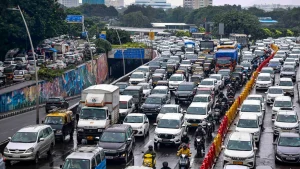Mumbai – Radhika Gupta, CEO of Edelweiss Mutual Fund, has thrust the spotlight on the Mumbai traffic nightmare plaguing India’s financial capital, revealing that commuters spend 45 minutes covering a mere 2-kilometer distance from Parel to Lower Parel. Her candid social media post has reignited conversations about traffic mismanagement in the bustling metropolis.
Origin of the Complaint
The Mumbai traffic nightmare discussion began when X user Nilesh Shah posted about commuters not following rules at the One BKC junction signal, leading to chaos and further delays. Shah documented the frustrating experience: “Record at One BKC junction signal. Eight minutes for Red Signal to turn Green.”
Shah further described how traffic wardens allowed vehicles to crisscross and block junctions, while commuters largely ignored official directions. “Traffic warden happily allows traffic to criss cross and block the junction. (Any way no one listened to him),” he wrote, suggesting penalties similar to those in Middle Eastern countries for blocking junctions.
Radhika Gupta’s “Slower Parel” Response
Responding to Shah’s complaint about the Mumbai traffic nightmare, Gupta highlighted the dire situation in Lower Parel through a clever wordplay, dubbing the area “Slower Parel” to emphasize the glacial pace of vehicular movement.
“Nilesh Bhai, if you would like to feel better I invite you to visit Slower Parel. It takes 45 mins minimum to go a 2km distance from Parel to Lower Parel,” Gupta wrote, drawing attention to what many consider one of the worst manifestations of the Mumbai traffic nightmare.
The 42-year-old CEO’s post struck a chord with thousands of commuters who experience similar frustrations daily while navigating the city’s congested roads.
Root Causes of the Crisis

Gupta identified specific factors contributing to the Mumbai traffic nightmare in the Parel-Lower Parel corridor. She pointed out that rules regarding no parking and one-way roads were being systematically violated, exacerbating the already challenging traffic situation.
“Many roads were supposed to have one way traffic and no parking to compensate for Elphinstone bridge shutting down. Unfortunately that is not being followed or enforced,” the CEO explained, highlighting the gap between traffic regulations and their implementation.
The Elphinstone bridge closure, intended to be offset by traffic management measures, has instead become another contributing factor to the Mumbai traffic nightmare as compensatory rules remain unenforced.
Call for Strict Enforcement
Concluding her observations about the Mumbai traffic nightmare, Gupta called for stringent enforcement of traffic rules to restore order to the city’s chaotic roads. Her appeal underscored the widespread frustration among Mumbaikars who lose precious hours daily to traffic congestion.
The CEO’s emphasis on enforcement rather than new regulations suggests that existing rules, if properly implemented, could significantly alleviate the Mumbai traffic nightmare without requiring additional infrastructure or legislation.
Mumbai Traffic Police Response
The official X handle of Mumbai Traffic Police responded to Gupta’s complaint about the Mumbai traffic nightmare, acknowledging the issue and promising action.
“We have informed concern Traffic Division for the necessary action,” the official handle posted, indicating that authorities had taken note of the high-profile complaint.
Also Read: OBC Protest Nagpur Kunbi: Massive Rally Against Maratha Reservation GR
However, many citizens remain skeptical about whether such responses translate into tangible improvements that would meaningfully address the Mumbai traffic nightmare.
Public Reaction and Similar Experiences
Dozens of X users rallied behind Radhika Gupta, sharing their own experiences of the Mumbai traffic nightmare across different parts of the city. The responses painted a picture of a citywide crisis rather than isolated incidents.
“These days nobody likes to follow rules. They feel insulting. Look at Mumbai local train travel. More than 50% people are unauthorized,” one commenter opined, linking the Mumbai traffic nightmare to broader issues of civic discipline.
Another user shared a comparison that challenged conventional wisdom about India’s traffic problems: “Last month it took me 2 and a half hours from BKC to Juhu. And yet the Bombay folks say Bangalore traffic is worse!” This comment sparked debates about which Indian city faces the worst traffic crisis.
Broader Implications for Mumbai
The Mumbai traffic nightmare highlighted by Gupta represents more than inconvenience—it affects productivity, quality of life, and the city’s competitiveness as a business hub. When senior executives spend 45 minutes traveling 2 kilometers, the economic cost compounds across millions of daily commuters.
The Lower Parel area, home to numerous corporate offices and a significant business district, experiences particularly acute manifestations of the Mumbai traffic nightmare. The concentration of commercial establishments without corresponding infrastructure upgrades has created a perfect storm of congestion.
Systemic Issues at Play
The Mumbai traffic nightmare stems from multiple systemic failures: inadequate enforcement of existing rules, insufficient infrastructure relative to vehicle population growth, lack of coordination between traffic management agencies, and widespread disregard for traffic regulations among commuters.
Gupta’s complaint about one-way roads and parking restrictions being ignored illustrates how even well-designed traffic management plans fail when implementation and enforcement remain weak.
Path Forward
Addressing the Mumbai traffic nightmare requires a multi-pronged approach: strict enforcement of existing regulations, improved traffic signal coordination, better public transportation alternatives, and civic education campaigns to encourage rule compliance.
Until authorities implement and sustain such measures, Mumbai’s reputation as a city where traveling 2 kilometers takes 45 minutes—earning areas like Lower Parel the unfortunate moniker “Slower Parel”—will continue to damage the city’s image and affect residents’ daily lives.

